Council Tax Reduction in Scotland: 2022-2023
Council Tax Reduction (CTR) awarded by age, household structure, income sources and employment status, deprivation index, and Council Tax band in the financial year from April 2022 to March 2023. It makes references to the previously published March 2022 for comparative purposes.
This document is part of a collection
2. Number of CTR Recipients
CTR data is reported monthly and this section presents analysis of CTR recipient numbers in 2022-23. The number of CTR recipients for each month from March 2022 to March 2023 is shown in Chart 2. The total number of CTR recipients in Scotland decreased from 462,670 recipients in March 2022 to 454,350 in March 2023, a decrease of 1.8 per cent during this period. However, the largest decrease (-1.2 per cent) in CTR recipients was observed in October 2022, with a low of 454,180 CTR recipients reached in December 2022- the lowest level recorded since the scheme started in April 2013.
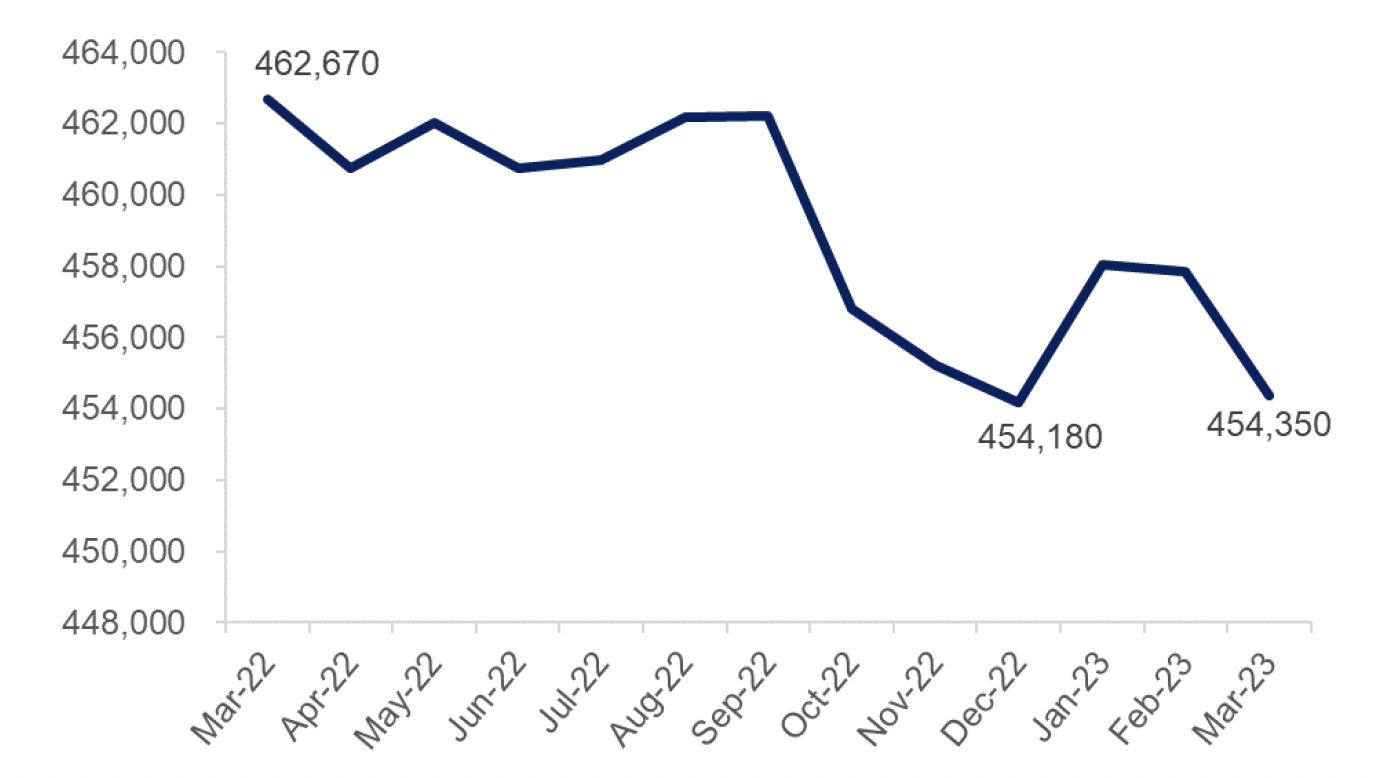
The number of CTR recipients in Scotland stayed relatively stable between March 2022 and September 2022, then decreased between September 2022 and March 2023, with a one month uptick in January 2023. This is in contrast to the gradual decrease in CTR recipients in Scotland observed in 2021-22 when the effects of Covid-19 were starting to lessen. The largest decrease was recorded in October 2022 as shown in Chart 3, when the total number of CTR recipients in Scotland decreased from September 2022 by 1.2 per cent (5,420 CTR recipients). Between March 2022 and September 2022, the largest fluctuation was 0.4 per cent compared with the period between October 2022 and March 2023, where the fluctuations were generally much higher, reaching as high as 1.2 per cent.
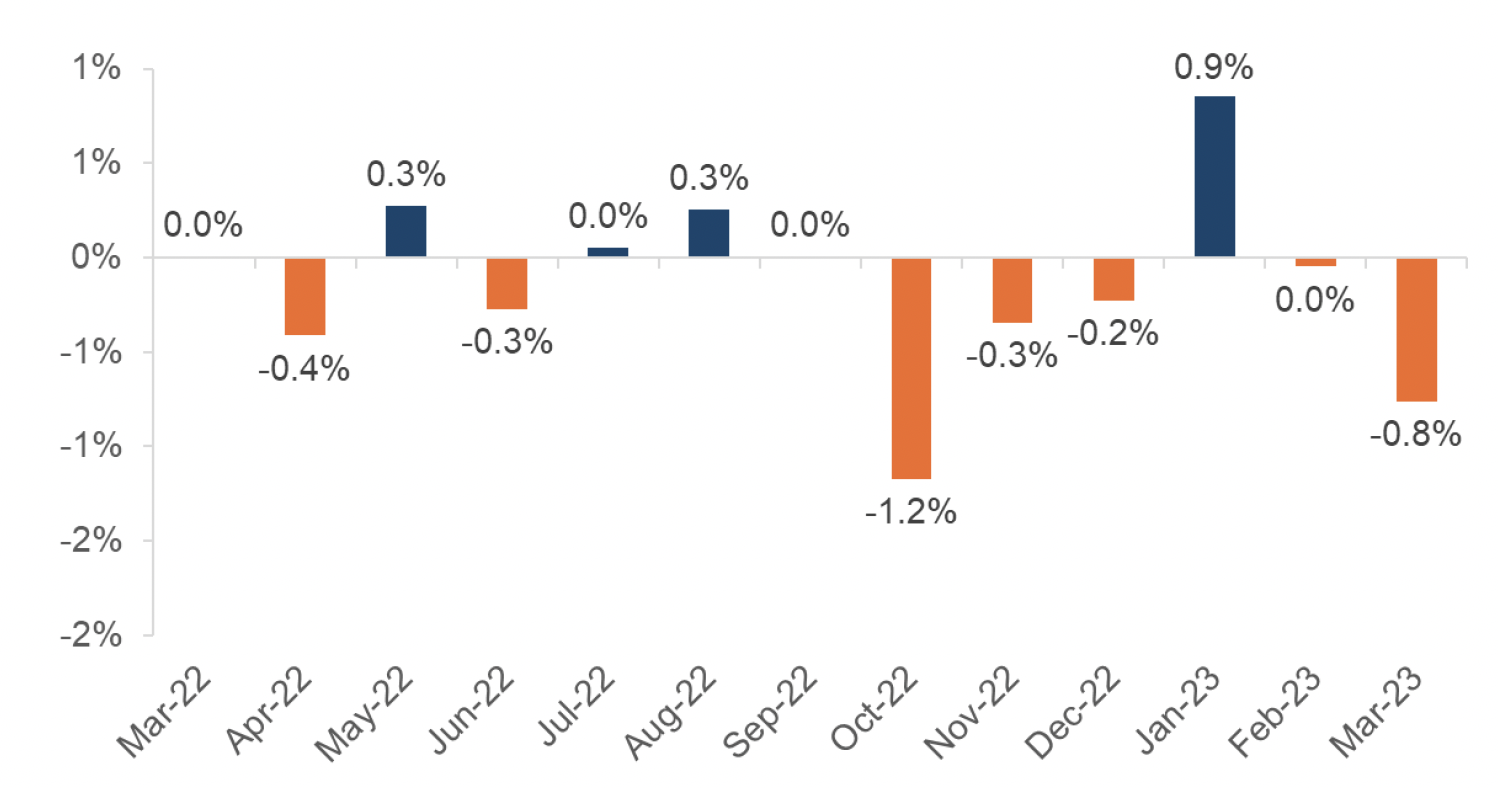
Table 2 (page 12) shows most local authorities recorded a decrease in CTR recipients between March 2022 and March 2023 (26 out of 32 local authorities), with the largest percentage decrease seen in East Renfrewshire (-7.0 per cent) followed by Renfrewshire (-6.6 per cent) and Shetland Islands (-4.5 per cent) over this period. Six local authorities recorded an increase during this period, with the largest percentage increase seen in Dumfries and Galloway (+3.9 per cent) followed by Falkirk (+2.5 per cent) and Inverclyde (+1.1 per cent). Due to differences in the number of chargeable dwellings and characteristics of local authorities, there have been fluctuations and different volumes of CTR recipient movements across local authorities during the financial year- see Chart 4.
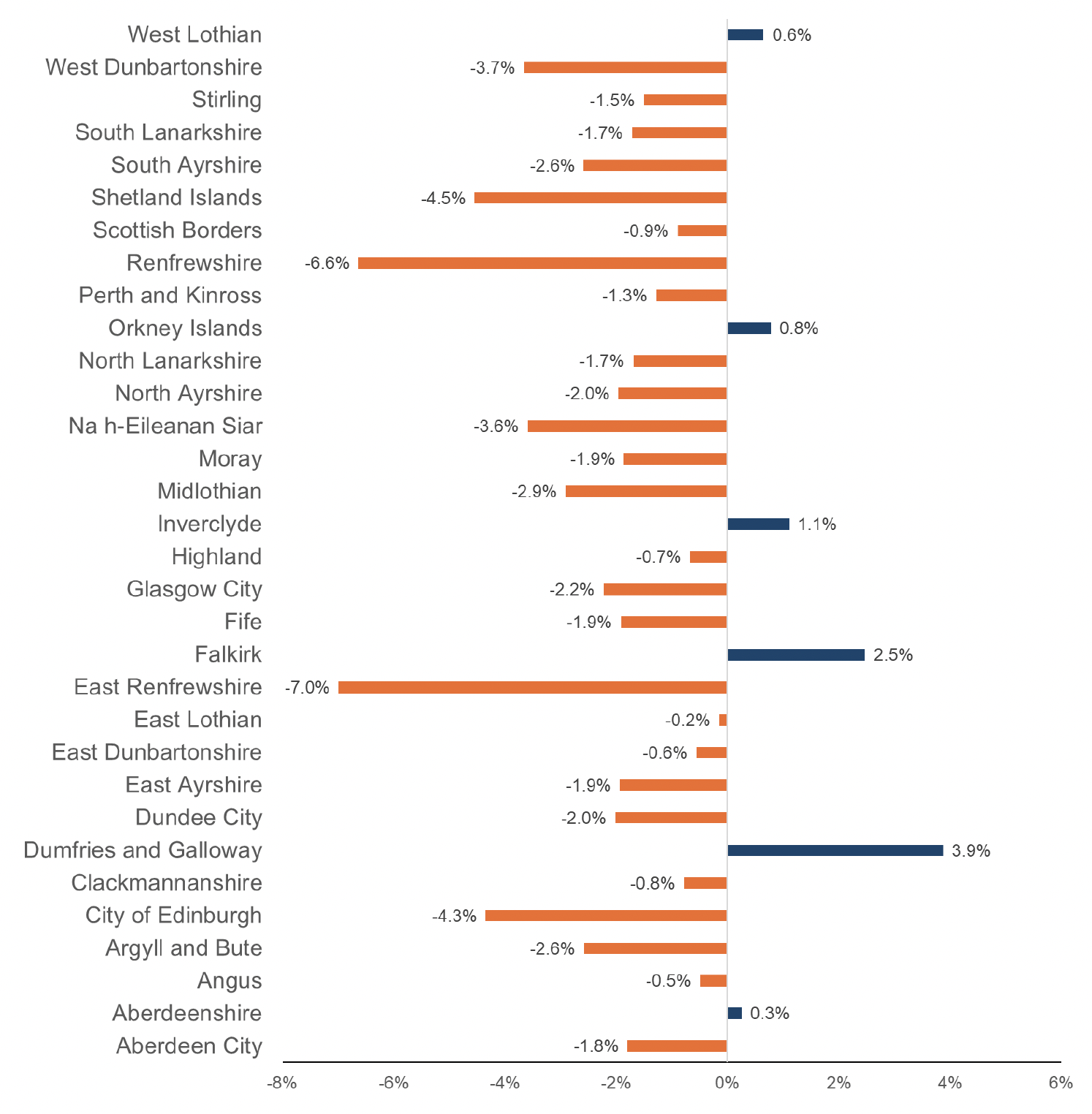
Details of CTR recipients and income forgone since the inception of CTR are available in the Recipients and Income Forgone tables published monthly.
| Mar-22 | Apr-22 | May-22 | Jun-22 | Jul-22 | Aug-22 | Sep-22 | Oct-22 | Nov-22 | Dec-22 | Jan-23 | Feb-23 | Mar-23 | % Change (Mar 22-Mar 23) |
|
|---|---|---|---|---|---|---|---|---|---|---|---|---|---|---|
| Scotland | 462,670 | 460,760 | 462,020 | 460,760 | 460,990 | 462,160 | 462,200 | 456,790 | 455,220 | 454,180 | 458,060 | 457,840 | 454,350 | -1.8% |
| Aberdeen City | 13,880 | 13,610 | 13,740 | 13,640 | 13,780 | 13,820 | 13,870 | 13,800 | 13,800 | 13,720 | 13,820 | 13,830 | 13,630 | -1.8% |
| Aberdeenshire | 11,750 | 11,760 | 11,900 | 11,830 | 11,830 | 11,780 | 11,810 | 11,660 | 11,620 | 11,690 | 11,690 | 11,690 | 11,780 | 0.3% |
| Angus | 8,140 | 8,170 | 8,160 | 8,180 | 8,120 | 8,130 | 8,110 | 8,020 | 7,990 | 8,110 | 8,030 | 8,080 | 8,100 | -0.5% |
| Argyll and Bute | 6,590 | 6,520 | 6,540 | 6,500 | 6,430 | 6,410 | 6,370 | 6,300 | 6,310 | 6,310 | 6,430 | 6,370 | 6,420 | -2.6% |
| City of Edinburgh | 32,200 | 31,600 | 32,050 | 31,820 | 31,460 | 31,350 | 31,540 | 31,410 | 31,230 | 31,080 | 30,820 | 30,770 | 30,800 | -4.3% |
| Clackmannanshire | 5,090 | 5,150 | 5,180 | 5,210 | 5,180 | 5,170 | 5,140 | 5,130 | 5,140 | 5,130 | 5,120 | 5,110 | 5,050 | -0.8% |
| Dumfries and Galloway | 12,660 | 12,650 | 12,820 | 12,760 | 12,830 | 12,890 | 13,020 | 12,870 | 12,910 | 12,920 | 13,200 | 13,370 | 13,150 | 3.9% |
| Dundee City | 17,320 | 17,350 | 17,080 | 17,130 | 17,280 | 17,350 | 17,370 | 17,020 | 16,950 | 16,960 | 17,050 | 17,070 | 16,970 | -2.0% |
| East Ayrshire | 12,900 | 12,910 | 12,920 | 12,860 | 12,830 | 12,910 | 12,860 | 12,660 | 12,620 | 12,610 | 12,690 | 12,750 | 12,650 | -1.9% |
| East Dunbartonshire | 5,390 | 5,440 | 5,490 | 5,540 | 5,540 | 5,590 | 5,530 | 5,420 | 5,330 | 5,330 | 5,300 | 5,320 | 5,360 | -0.6% |
| East Lothian | 6,620 | 6,660 | 6,770 | 6,720 | 6,700 | 6,720 | 6,720 | 6,680 | 6,700 | 6,710 | 6,700 | 6,610 | 6,610 | -0.2% |
| East Renfrewshire | 4,720 | 4,610 | 4,580 | 4,560 | 4,570 | 4,550 | 4,520 | 4,500 | 4,450 | 4,470 | 4,500 | 4,510 | 4,390 | -7.0% |
| Falkirk | 12,560 | 12,630 | 12,690 | 12,690 | 12,700 | 12,750 | 12,790 | 12,650 | 12,650 | 12,680 | 12,730 | 12,960 | 12,870 | 2.5% |
| Fife | 29,780 | 29,860 | 29,840 | 29,660 | 29,650 | 29,680 | 29,560 | 29,090 | 29,020 | 28,860 | 29,070 | 29,250 | 29,210 | -1.9% |
| Glasgow City | 85,980 | 86,050 | 86,080 | 86,120 | 86,500 | 87,170 | 86,930 | 86,050 | 85,180 | 84,450 | 84,980 | 84,750 | 84,060 | -2.2% |
| Highland | 16,260 | 16,170 | 16,120 | 16,110 | 16,090 | 16,170 | 16,100 | 16,020 | 16,080 | 16,210 | 16,420 | 16,230 | 16,150 | -0.7% |
| Inverclyde | 9,070 | 8,860 | 9,000 | 8,990 | 9,160 | 9,190 | 9,510 | 9,140 | 9,120 | 9,150 | 9,470 | 9,470 | 9,170 | 1.1% |
| Midlothian | 5,840 | 5,820 | 5,840 | 5,850 | 5,840 | 5,850 | 5,820 | 5,780 | 5,810 | 5,770 | 5,830 | 5,900 | 5,670 | -2.9% |
| Moray | 5,370 | 5,360 | 5,350 | 5,350 | 5,350 | 5,300 | 5,280 | 5,240 | 5,230 | 5,230 | 5,310 | 5,250 | 5,270 | -1.9% |
| Na h-Eileanan Siar | 1,950 | 1,940 | 1,940 | 1,930 | 1,920 | 1,920 | 1,900 | 1,890 | 1,900 | 1,900 | 1,880 | 1,880 | 1,880 | -3.6% |
| North Ayrshire | 16,830 | 16,420 | 16,720 | 16,700 | 16,710 | 16,760 | 16,720 | 16,380 | 16,410 | 16,330 | 16,790 | 16,730 | 16,500 | -2.0% |
| North Lanarkshire | 34,830 | 34,900 | 34,900 | 34,530 | 34,540 | 34,590 | 34,540 | 34,290 | 34,200 | 34,040 | 34,720 | 34,330 | 34,240 | -1.7% |
| Orkney Islands | 1,290 | 1,280 | 1,290 | 1,360 | 1,300 | 1,290 | 1,280 | 1,300 | 1,250 | 1,340 | 1,270 | 1,320 | 1,300 | 0.8% |
| Perth and Kinross | 8,580 | 8,570 | 8,570 | 8,620 | 8,540 | 8,640 | 8,590 | 8,430 | 8,440 | 8,500 | 8,480 | 8,520 | 8,470 | -1.3% |
| Renfrewshire | 17,040 | 16,590 | 16,650 | 16,510 | 16,450 | 16,490 | 16,500 | 16,380 | 16,260 | 16,140 | 16,290 | 16,200 | 15,910 | -6.6% |
| Scottish Borders | 7,800 | 7,890 | 7,850 | 7,810 | 7,820 | 7,810 | 7,930 | 7,880 | 7,760 | 7,750 | 7,790 | 7,810 | 7,730 | -0.9% |
| Shetland Islands | 1,100 | 1,090 | 1,090 | 1,100 | 1,100 | 1,100 | 1,100 | 1,080 | 1,090 | 1,070 | 1,070 | 1,070 | 1,050 | -4.5% |
| South Ayrshire | 10,060 | 10,030 | 10,030 | 9,950 | 9,940 | 9,970 | 9,960 | 9,830 | 9,830 | 9,800 | 9,870 | 9,910 | 9,800 | -2.6% |
| South Lanarkshire | 30,890 | 31,000 | 30,880 | 30,760 | 30,840 | 30,780 | 30,740 | 30,110 | 30,010 | 30,010 | 30,670 | 30,760 | 30,360 | -1.7% |
| Stirling | 5,300 | 5,310 | 5,310 | 5,310 | 5,320 | 5,370 | 5,370 | 5,200 | 5,260 | 5,260 | 5,280 | 5,290 | 5,220 | -1.5% |
| West Dunbartonshire | 10,930 | 10,660 | 10,710 | 10,770 | 10,750 | 10,730 | 10,790 | 10,740 | 10,780 | 10,720 | 10,680 | 10,620 | 10,530 | -3.7% |
| West Lothian | 13,970 | 13,910 | 13,910 | 13,920 | 13,920 | 13,960 | 13,950 | 13,860 | 13,890 | 13,920 | 14,140 | 14,120 | 14,060 | 0.6% |
Notes:
1. Recipients are as at monthly count date. See Methodology notes section 2 for more details: www.gov.scot/publications/council-tax-reduction/
2. Figures are rounded to the nearest 10. Components may not sum to total due to rounding.
Chart 5 shows the number of CTR recipients by local authority as a proportion of the Scottish CTR population for March 2023 in descending order. It can be seen that Glasgow City accounted for the highest proportion, with almost one-fifth of all CTR recipients in Scotland which is more than twice the number of CTR recipients in North Lanarkshire (the next highest ranking authority).
The five local authorities with the highest numbers of CTR recipients accounted for almost half (46 per cent) of the total number of CTR recipients for Scotland in March 2023, similar to March 2022. Their ordering has not changed from last year. This can be attributed to the size of the local authorities where those with larger populations may be expected to have a higher number of CTR claimants and therefore recipients. These five local authorities are:
- Glasgow City accounting for 19 per cent (84,060 CTR recipients);
- North Lanarkshire accounting for 8 per cent (34,240 CTR recipients);
- City of Edinburgh accounting for 7 per cent (30,800 CTR recipients);
- South Lanarkshire accounting for 7 per cent (30,360 CTR recipients); and
- Fife accounting for 6 per cent (29,210 CTR recipients).
In contrast, the three island authorities accounted for just 1 per cent when combined together, with only 0.4 per cent in Na h-Eileanan Siar (1,880 CTR recipients), 0.3 per cent in Orkney Islands (1,300 CTR recipients) and with the Shetland Islands accounting for 0.2 per cent, the least (1,050 CTR recipients). Similarly, the order and proportion of these island authorities were the same in March 2022.
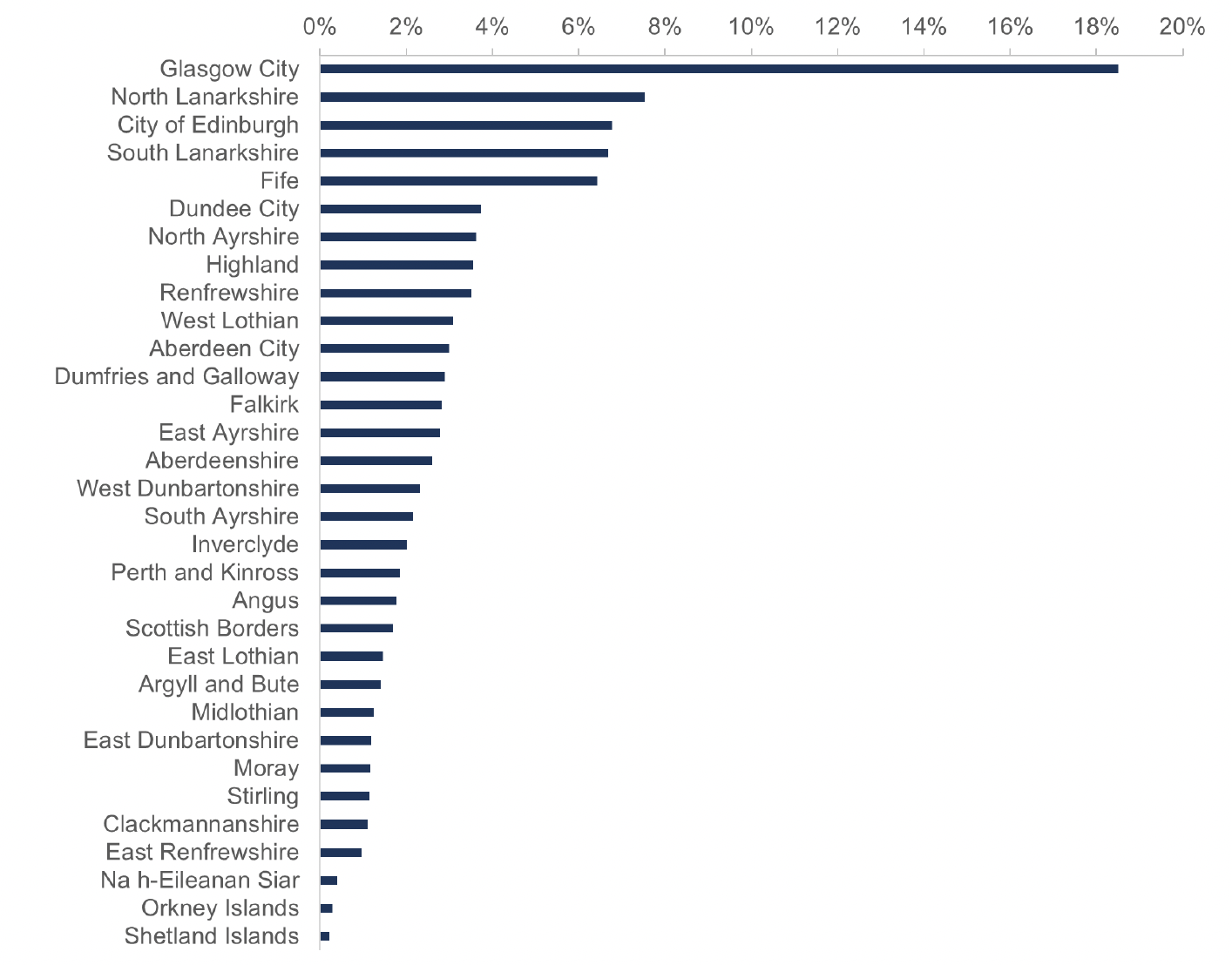
2.1 CTR recipients over time
From the introduction of the CTR scheme in April 2013 to March 2023, the number of households receiving CTR in Scotland has gradually decreased from 552,380 in April 2013 to 454,350 in March 2023. However there were large rises in caseload in 2020 due to the initial economic impact of Covid-19 (as shown in Chart 1 on page 1). During 2022-23, the number of CTR recipients was relatively stable for the first half of the year, then decreased in all remaining months, except for an increase in January 2023. The number of CTR recipients is now 18 per cent (98,030 recipients) lower in March 2023 than when the scheme began.
All local authorities in Scotland have seen a decrease in the number of CTR recipients since the scheme was introduced in April 2013. Chart 6 shows the percentage change between April 2013 and March 2023 for all local authorities in Scotland.
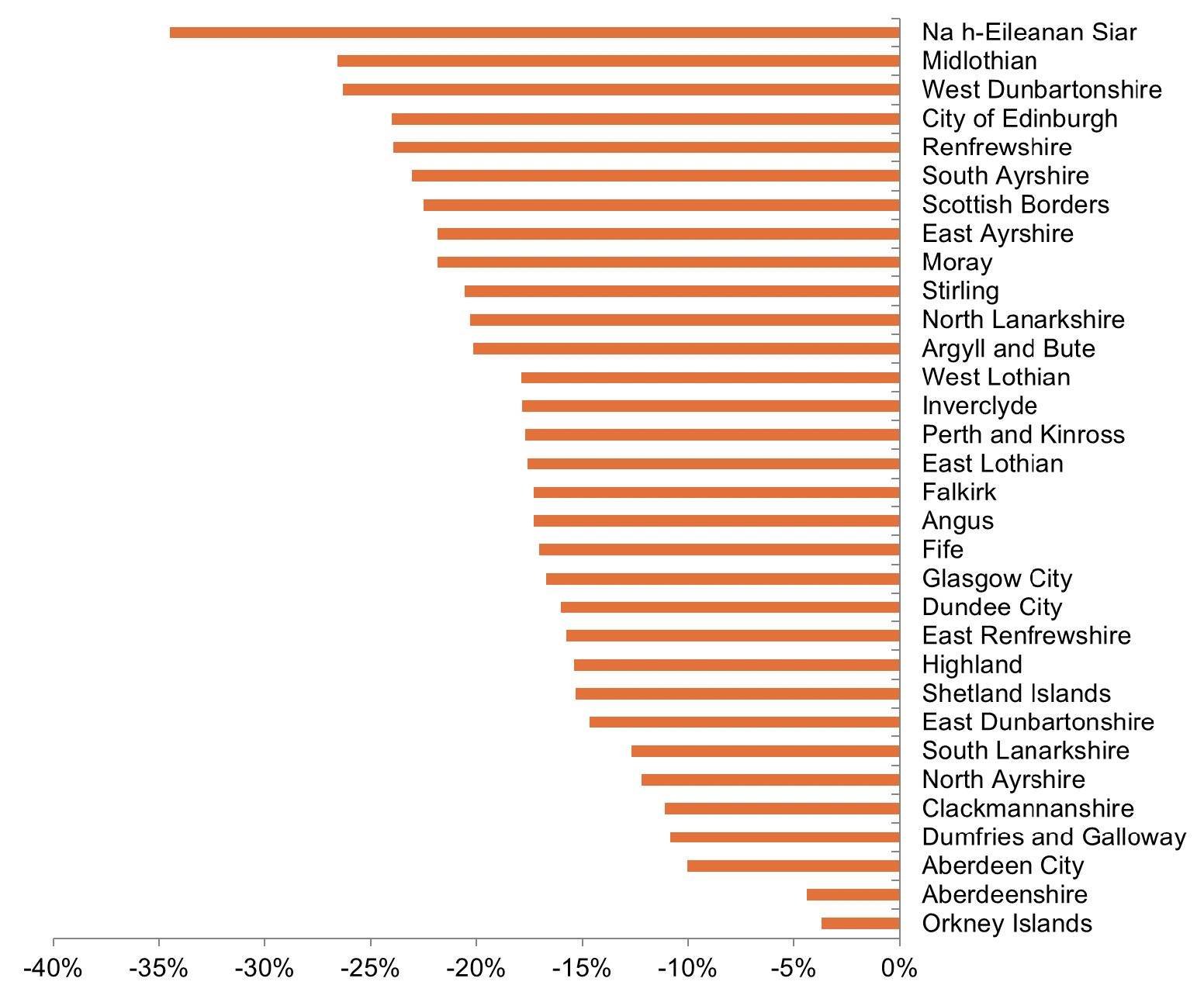
The largest percentage decreases in the number of CTR recipients were in Na h-Eileanan Siar (-35 per cent), Midlothian (-27 per cent) followed by West Dunbartonshire (-26 per cent). Whilst Na h-Eileanan Siar has a large percentage decrease, this represents a relatively small number of CTR recipients.
2.2 CTR recipients by passported status
In March 2023, passported CTR recipients accounted for 42 per cent of all CTR recipients. This is down from 44 per cent in March 2022, and part of a decreasing trend from 63 per cent in March 2018. UC does not passport claimants to 100 per cent CTR so as the number of people on UC rises, the number of non-passported cases is expected to increase. As seen from Chart 7, the most common passporting benefits are Employment and Support Allowance (Income related) and Pension Credit (Guarantee Credit) which made up 39 per cent of all CTR recipients in March 2023, similar to March 2022. The majority (82 per cent) of non-passported CTR recipients in March 2023 were not in employment, down slightly from 86 per cent in March 2022. The proportion of passporting CTR recipients from Income Support and Jobseekers Allowance has continued to decrease and in March 2023 made up only 3 per cent of all CTR recipients.
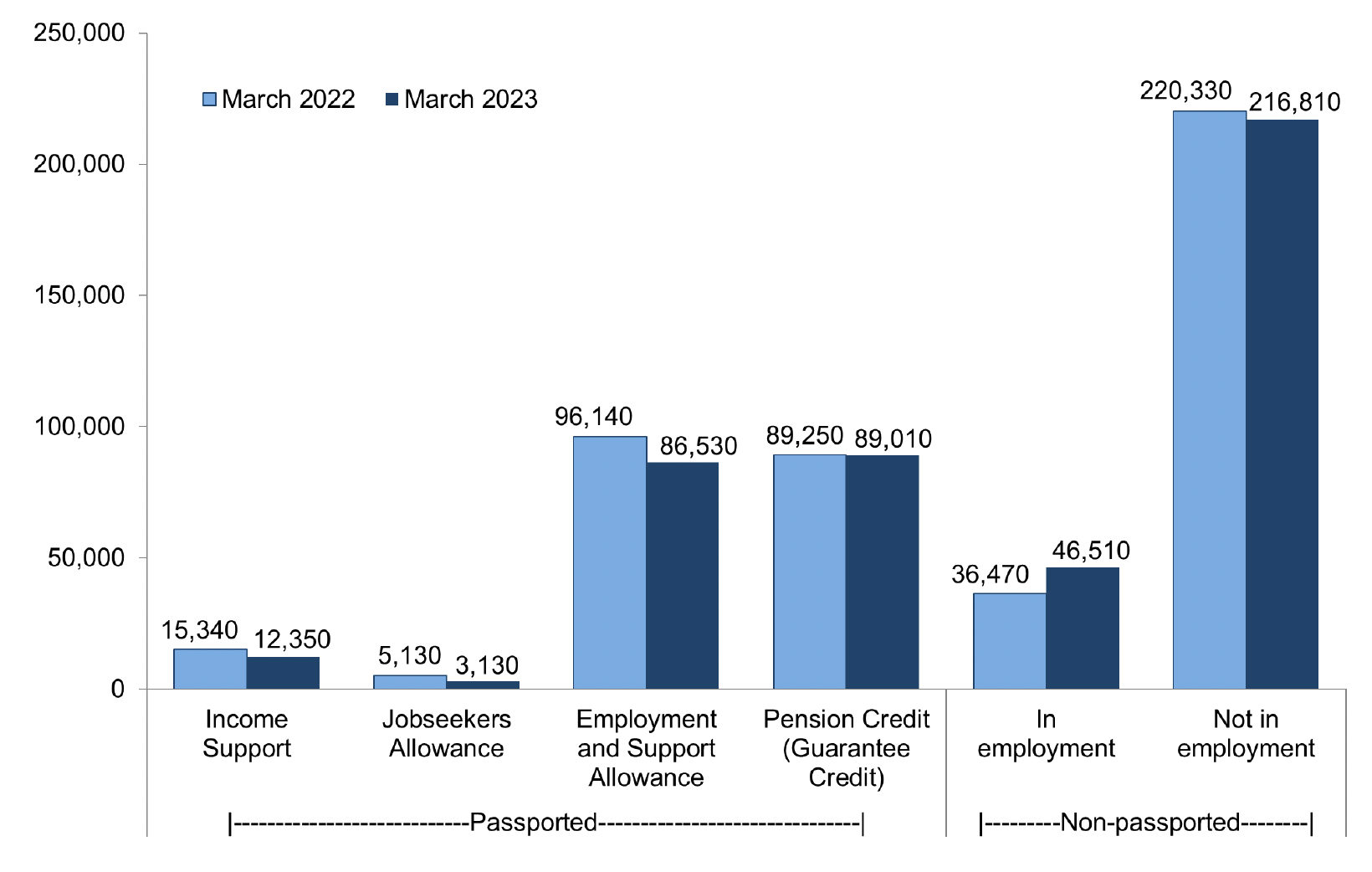
With the general increase in UC claimants during the pandemic, there has been a change in the balance of passported and non-passported CTR recipients, with non-passported CTR recipients continuing to account for more than passported CTR recipients. As can be seen in Chart 8, there has been a gradual decrease of passported CTR recipients (-7 per cent) and an increase in non-passported CTR recipients (+3 per cent) between March 2022 and March 2023. This is in contrast to a decrease of 5 per cent observed for non-passported CTR recipients between March 2021 and March 2022. In March 2023, passported and non-passported CTR recipients accounted for 42 per cent and 58 per cent of all CTR recipients respectively.
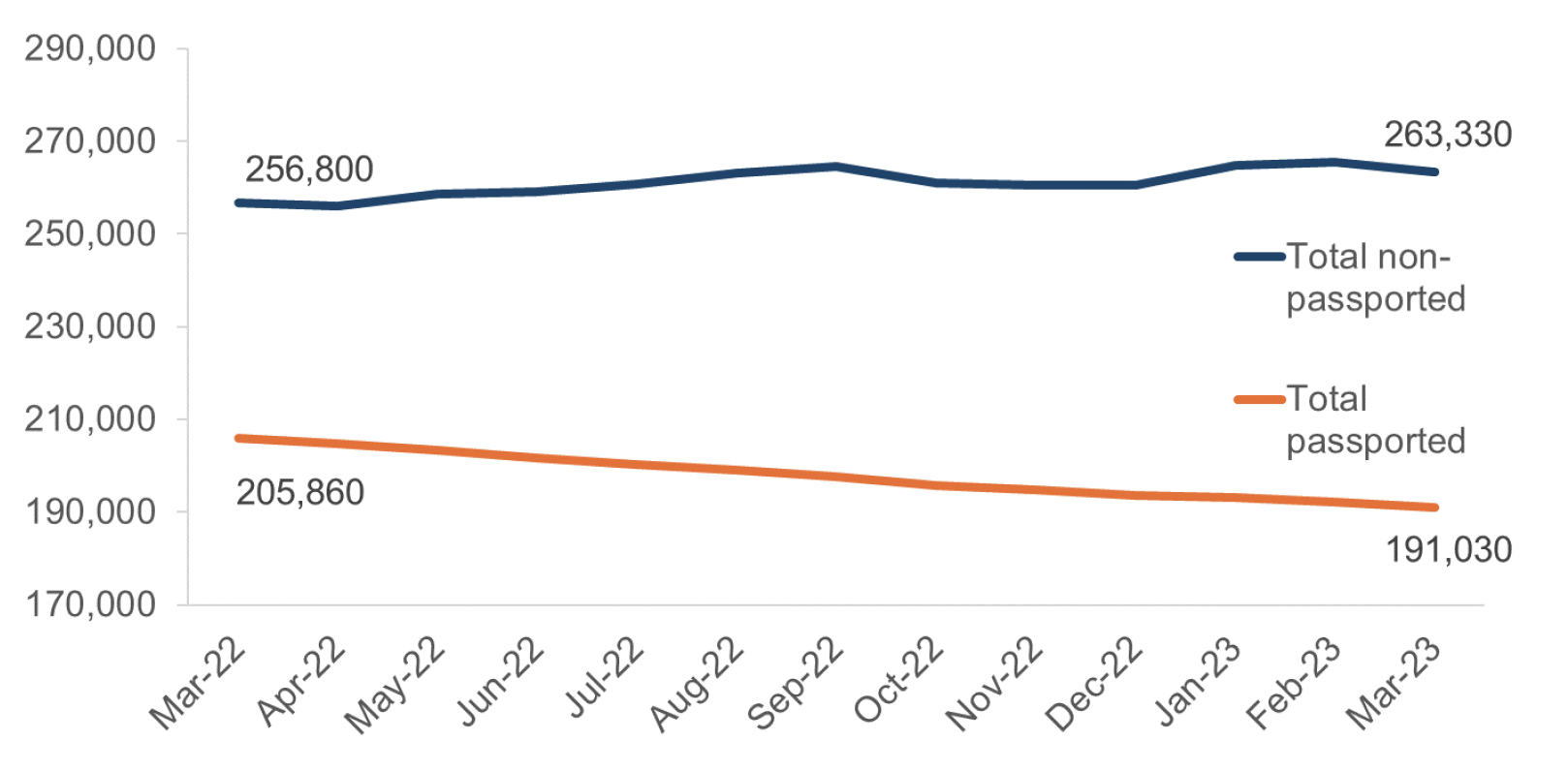
As can be seen in Chart 9, the proportion of each passported benefit as a percentage of all CTR recipients between March 2022 and March 2023 has remained similar. For non-passported CTR recipients, there has been a slight increase in the proportion of those employed as a percentage of all CTR recipients with those in employment now accounting for 10 per cent of all CTR recipients in March 2023 (up from 8 per cent in March 2022). The proportion of non-passported CTR recipients not in employment is the same as March 2022.
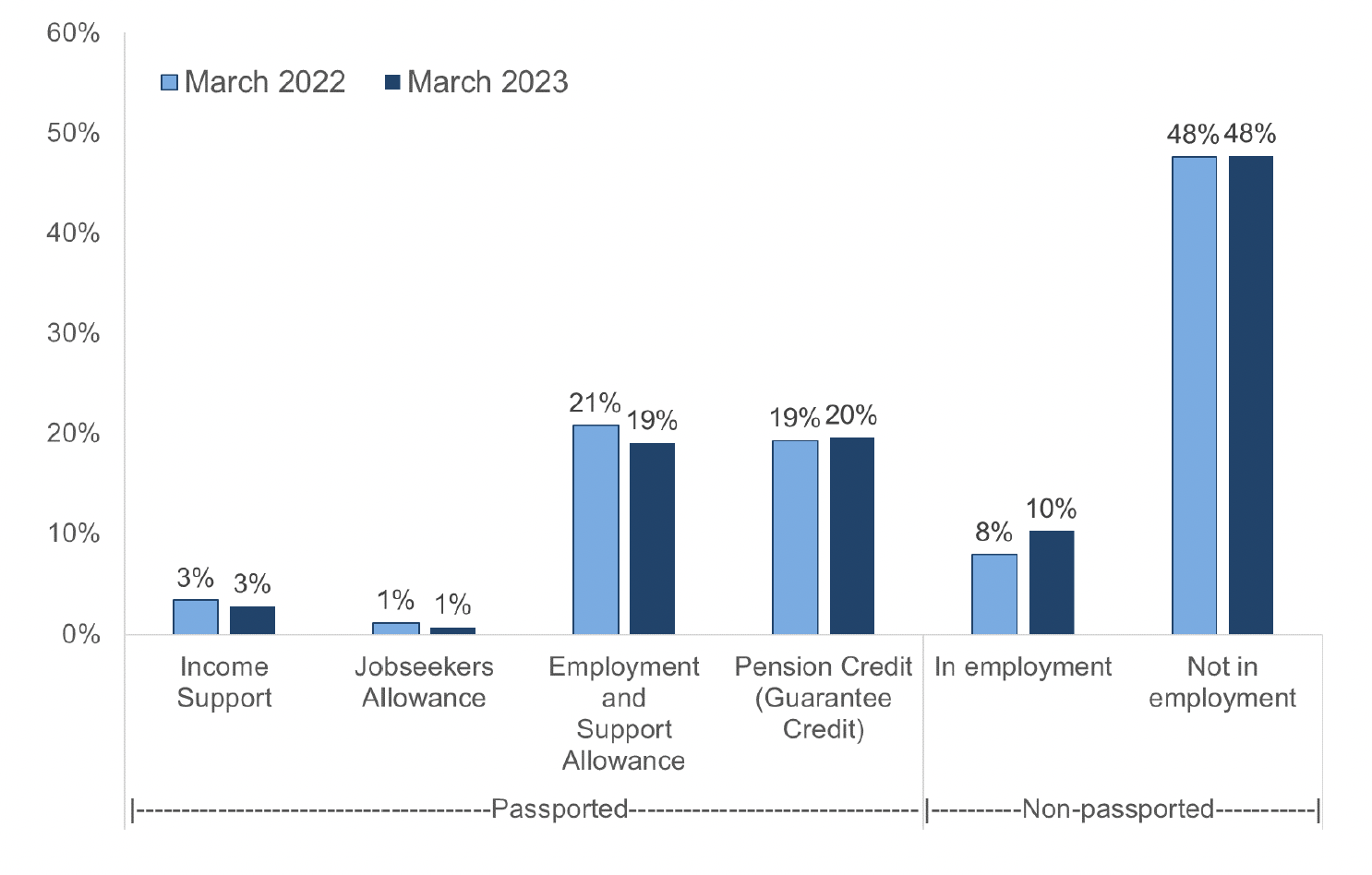
The number of CTR recipients by passported status and local authority in March 2023 is available in the supplementary tables. Some key variations across local authorities are:
- Na h-Eileanan Siar (55 per cent), Glasgow City (48 per cent) and West Dunbartonshire (48 per cent) had the highest proportion of passported CTR recipients. This represents a decrease in proportion for both Na h-Eileanan Siar and Glasgow City and an increase in proportion for West Dunbartonshire in comparison to March 2022 (57 per cent, 51 per cent and 44 per cent respectively).
- Clackmannanshire (34 per cent), East Lothian (34 per cent) and Aberdeenshire (35 per cent) had the lowest proportions of passported CTR recipients in March 2023 compared to 37 per cent, 36 per cent and 38 per cent respectively in March 2022.
2.3 CTR recipients by age and family type
Chart 10 shows the number of CTR recipients by age group in March 2023. Between March 2022 and March 2023, the number of CTR recipients decreased for all age groups, except for those aged 35 to 44 which increased by 1 per cent. Those aged under 25 decreased the most (-7 per cent) between March 2022 and March 2023.
The age group with the highest proportion of CTR recipients continues to be those aged 65 and over, at 36 per cent (163,180 CTR recipients) in March 2023, the same proportion as in March 2022. The March 2023 proportions of CTR recipients for all other age groups were similar to those in March 2022, with similar proportions also observed during the financial year. The age group with the lowest proportion were those aged under 25 at 3 per cent (12,230 CTR recipients). This can in part be explained by the fact there are generally less individuals aged under 25 years old with Council Tax liability and therefore applying for CTR.
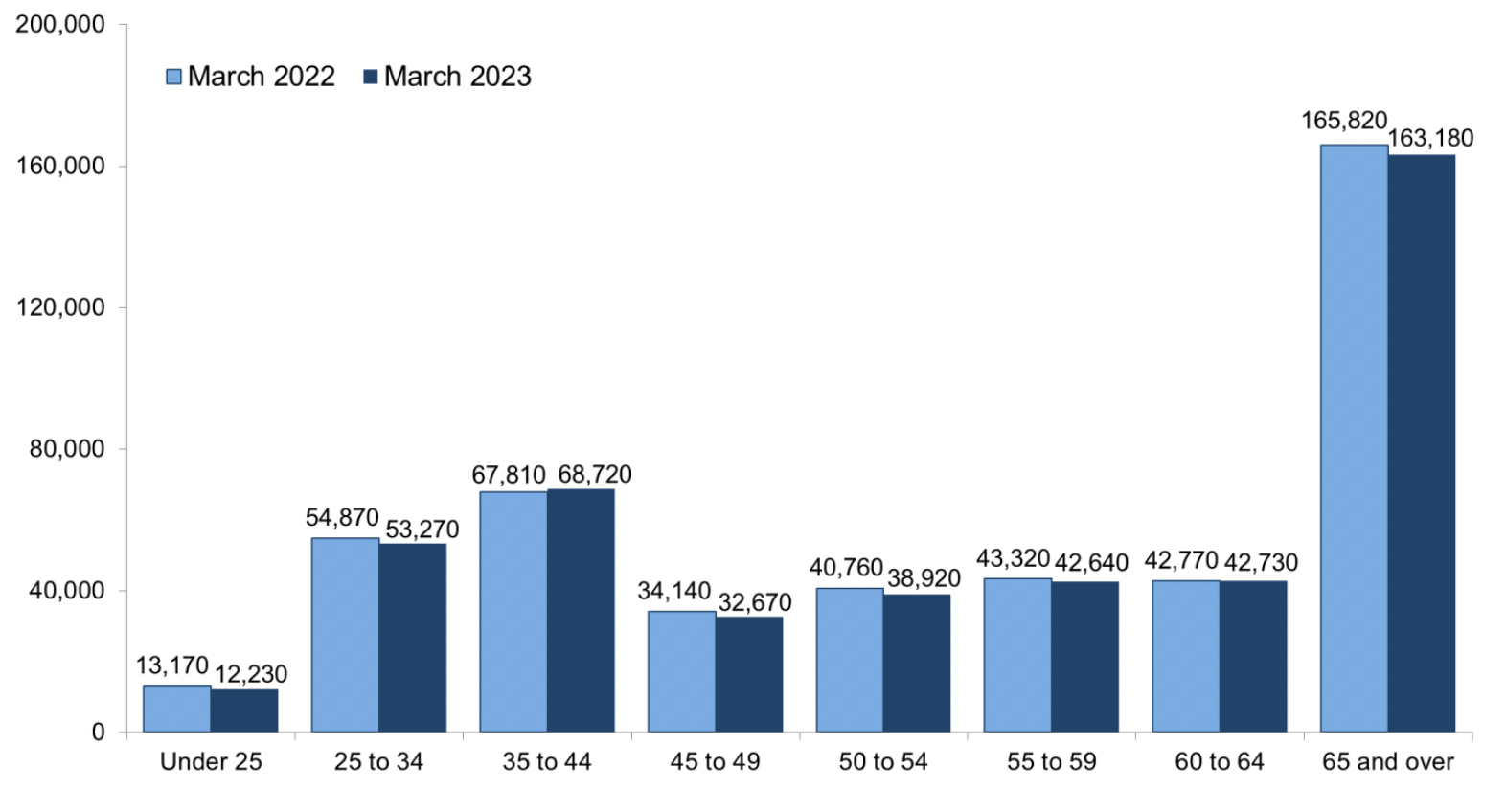
Chart 11 shows the number of CTR recipients by family type in March 2023. Between March 2022 and March 2023, CTR recipients decreased for all family types, except for lone parents. The number of lone parents receiving CTR rose to 75,100 (an increase of 3 per cent), with couples with no child dependants showing the largest decrease of 6 per cent, dropping to 45,820 CTR recipients.
In March 2023, over two thirds of CTR recipients (68 per cent) were single with no child dependent, the same as in March 2022. Lone parents make up 17 per cent, a rise from 16 per cent in March 2022, and 15 per cent were couples (with or without children), a slight decrease from March 2022 where they accounted for 16 per cent of recipients.
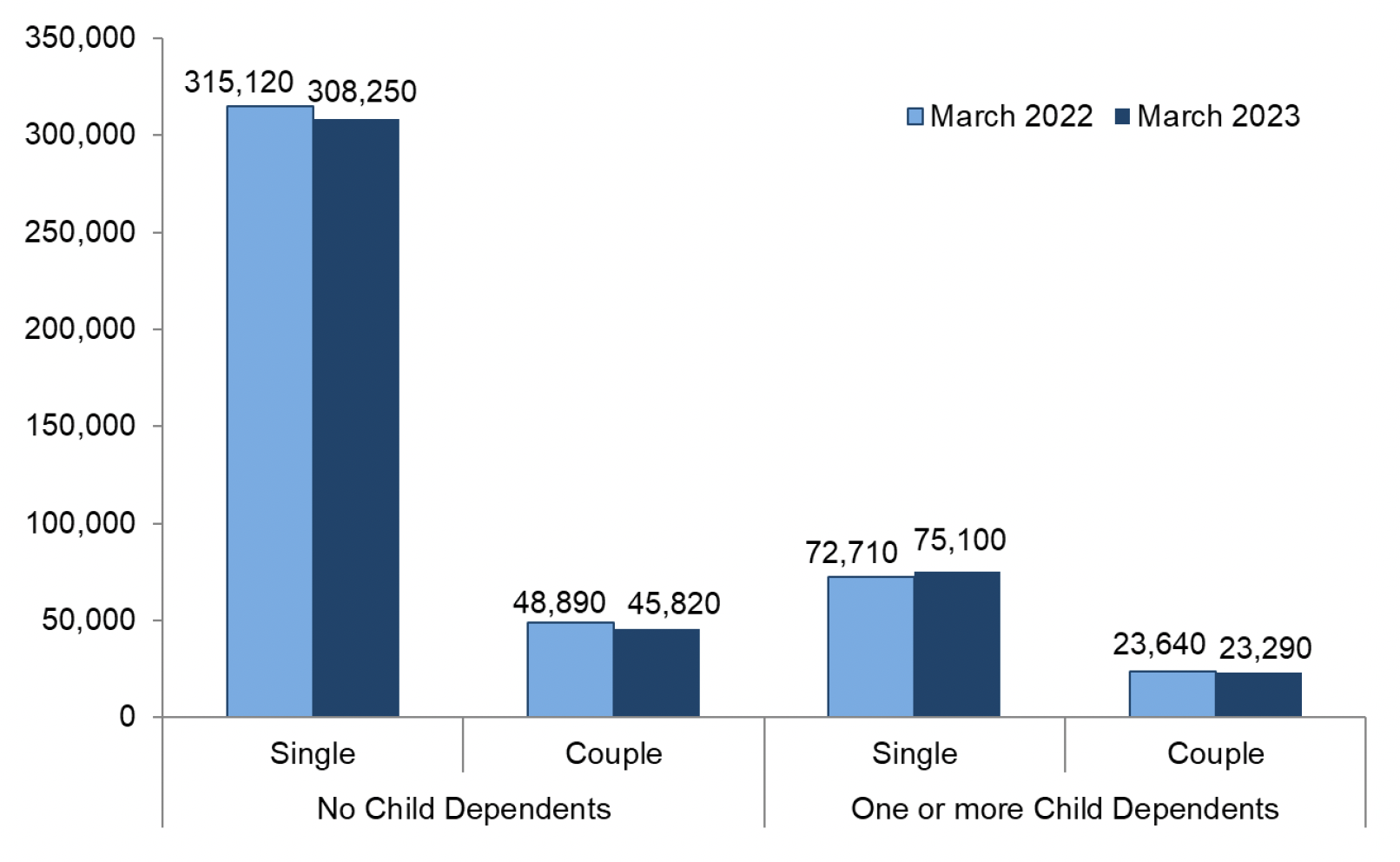
2.4 CTR recipients by deprivation
The Scottish Index of Multiple Deprivation (SIMD) is the Scottish Government's official tool for identifying areas of multiple deprivation. It divides Scotland into 6,976 datazones, each containing around 350 households or approximately 700-800 people. Each datazone has a calculated 'deprivation score' and these scores are then used to rank the datazones. Decile 1 contains the ten per cent most deprived datazones, Decile 2 contains the next ten per cent most deprived, and so on.
It should be noted that the overall SIMD score is a relative measure and assesses deprivation across seven domains – income, employment, education, health, access to services, crime and housing. The CTR scheme is principally concerned with income and household circumstances as a basis for making awards (see Figure 2 on page 8).
Between March 2022 and March 2023, CTR recipients decreased in all deciles with the percentage decrease greatest in the least deprived datazone (see Supplementary Table 2.9). This percentage change may be greater at the lower deprivation levels as the numbers of CTR recipients are smaller resulting in larger percentage decreases. Decile 1 decreased by 2 per cent whilst decile 10 decreased by 6 per cent. Chart 12 shows the spread of CTR recipients across areas of deprivation, using SIMD deciles as described above, which shows that the proportions in each decile have remained similar to proportions in March 2022 despite the decreases observed at a decile level. It can be observed that CTR recipients continue to be heavily concentrated in areas of highest deprivation, with 58 per cent of CTR recipients (261,220) in the lowest three deciles in March 2023 the same proportion as in March 2022.
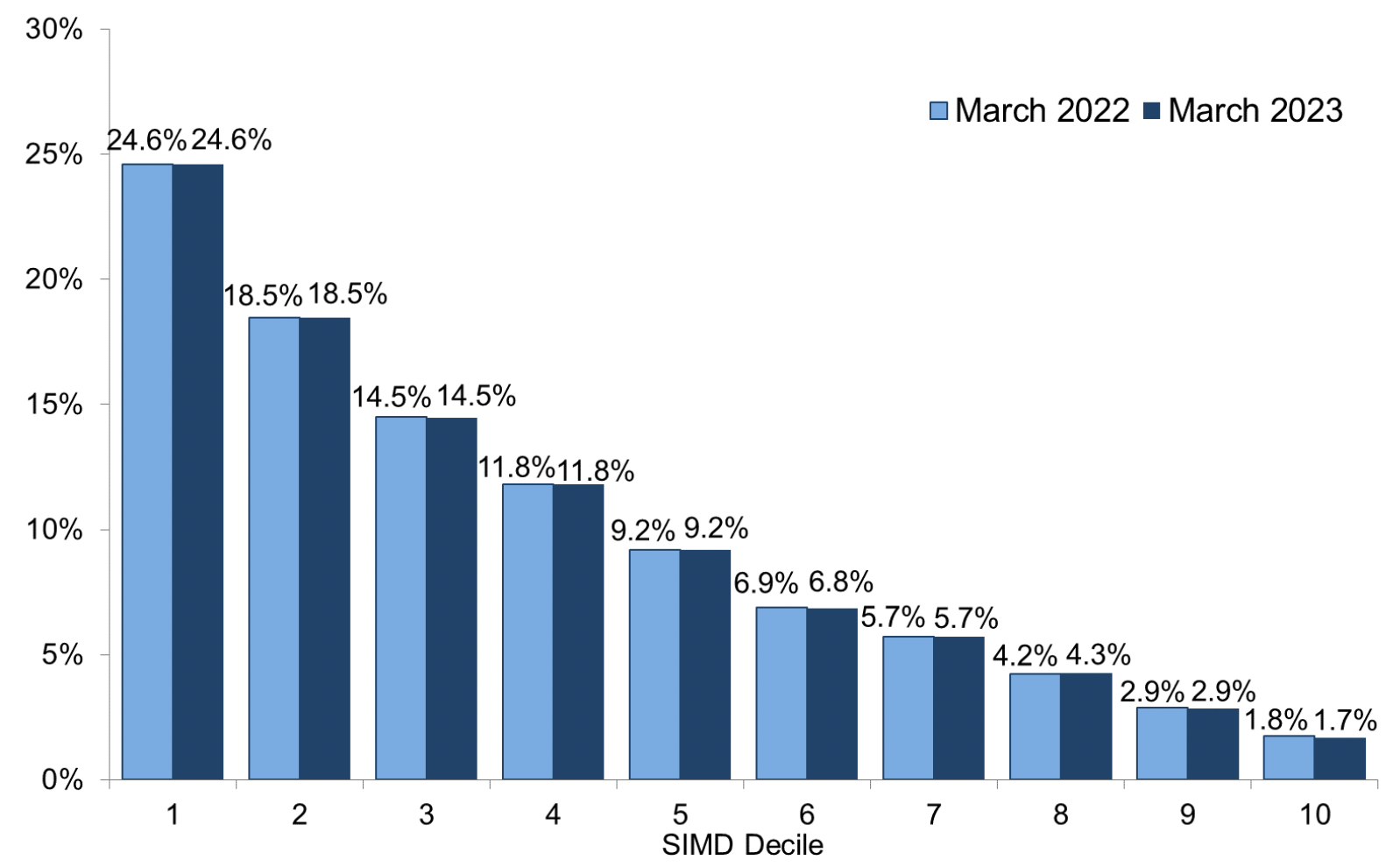
Further details of SIMD2020 are available at https://www.gov.scot/news/scottish-index-of-multiple-deprivation-2020/.
2.5 Full and partial CTR
Full CTR refers to CTR recipients whose Council Tax liability is reduced to zero. Partial CTR refers to CTR recipients whose Council Tax liability is reduced, but they are still liable to pay some Council Tax. Further details on these terms and how CTR is calculated are given in Section 1.1.
Between March 2022 and March 2023, the number of CTR recipients decreased for those that received partial award status and increased for those that received full award status. Partial CTR decreased by 19 per cent and full CTR increased by 2 per cent. The number of CTR recipients by full or partial award and passported status from March 2022 to March 2023 is available in the supplementary tables.
Chart 13 compares the number of CTR recipients in March 2022 and March 2023 by full or partial award and passported status. It can be seen that the decrease in CTR recipients is predominantly driven by the 19 per cent decrease in non-passported and partial CTR recipients and the 7 per cent decrease in passported and full CTR recipients. Between these two groups, there is a decrease of 31,110 recipients in comparison to March 2022. It should be noted that despite the overall decrease in CTR recipients, there was a relatively large increase in non-passported and full CTR recipients of 14 per cent, rising to 192,830 recipients in March 2023.
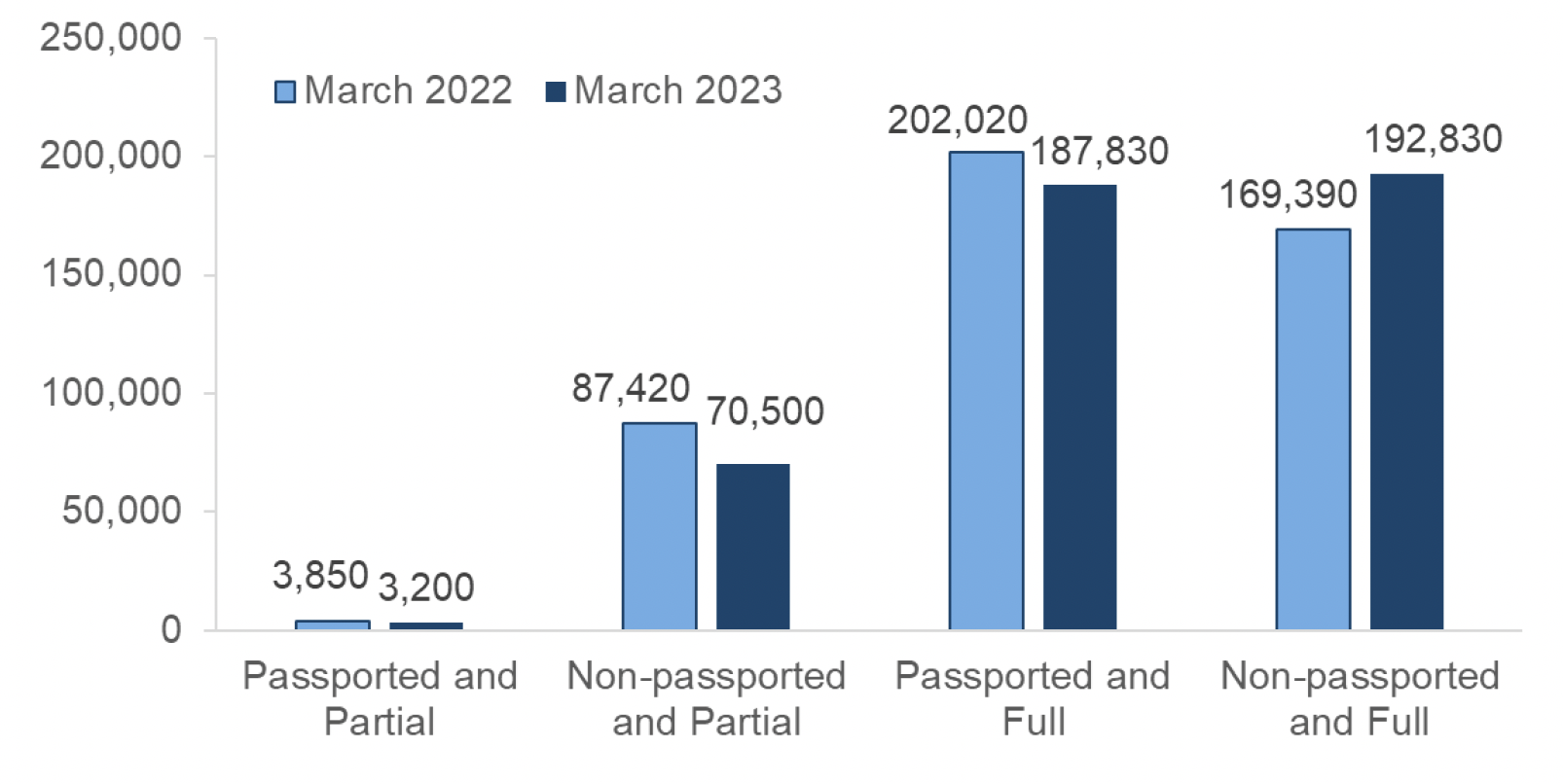
The proportion of CTR recipients receiving full CTR who are in receipt of a passporting benefit and have no non-dependants[1] living in their household was 41 per cent in March 2023 compared to 44 per cent in March 2022. During this time, the proportion of CTR recipients receiving full CTR from a non-passporting benefit increased by 3 per cent gradually from April 2022 to 42 per cent in March 2023. Chart 14 compares the proportion of CTR recipients by full or partial award between March 2023 and March 2022.
In March 2023, 58 per cent of CTR recipients were non-passported CTR recipients, a rise from 56 per cent in March 2022. Of this, 42 per cent of CTR recipients (192,830) were awarded full CTR and the remainder (70,500 CTR recipients) were awarded partial CTR.
Of all CTR recipients, more than four-fifths (84 per cent, 380,660 CTR recipients) were in receipt of full CTR in March 2023, a slight increase from March 2022 (80 per cent).
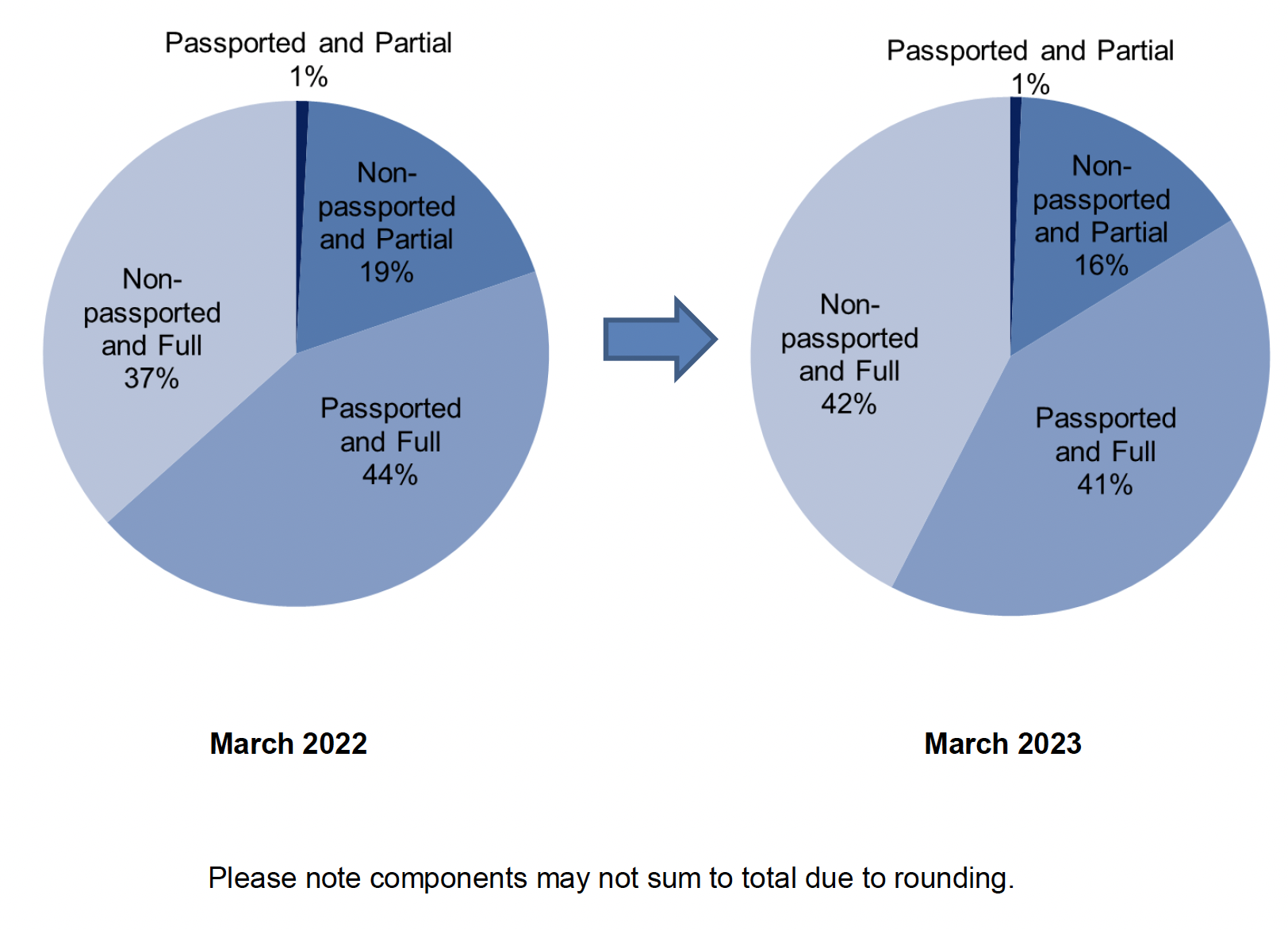
Contact
Email: lgfstats@gov.scot
There is a problem
Thanks for your feedback